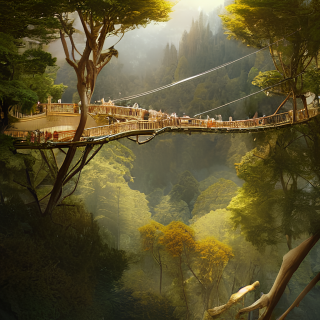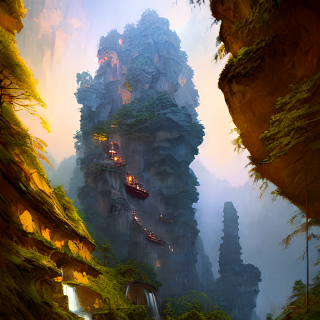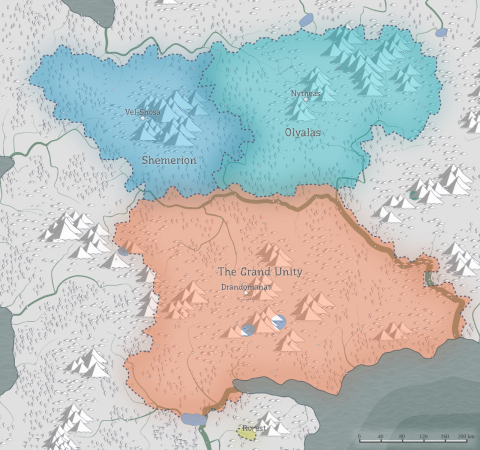In The Fireflow cultural block dwarves and elves, considering themselves to be the “elder species”, live together. The largest cities on Eleath, based around mineral-rich groupings of tepui and the trees between them belong to them.
Foundation
The Fireflow culture was formed between six and seven hundred years ago when an end was brought to age-old rivalry, and in fact often open warfare, between elves and dwarves. The end to The Rivalry came when the kings Trabalar Amberdew of the elves and Strobrahr Hjalstrohm of the dwarves fell in love. They merged their households into one, effectively creating a new type of polyamorous marriage that has become known as a hearthbond, and encouraged others to do the same. Elves and dwarves had more in common than they had known - both loving beautiful things of wood, metal and stone, good food and fine brews for mug and goblet, and found themselves surprisingly personally compatible.
The resulting state, at the time encompassing the whole Fireflow culture, is known as The Grand Unity.
Hearthbonds
The two species found themselves so compatible, in fact that most in the Fireflow follow the pattern of Kings Amberdew and Hjalstrom and live in extended households of 2 to 12 adults known as Hearthbonds. These are like a marriage in that they are permanent, love-matched relationships and usually involve a mixture of elves and dwarves. While brand new Hearthbonds are regularly formed, some are multigenerational with new members brought in by each new generation.
(When new members are brought in to a multi-generational Hearthbond they are normally romantically involved with one or more of the members, but are not expected to be romantically involved with them all. They are, however, expected to form a bond of caring trust with all of them, joining themselves to the Hearthbond’s values and name - mutual trust and care among all members being considered of paramount importance.)
Elves and dwarves certainly share romance in their Hearthbonds, but cannot produce children together, meaning that all offspring are either dwarfs or elves, but they are brought up by all in the Hearthbond so share its family identity and culture.
Even after hundreds of years of the Fireflow it remains true that dwarves are often stronger and more down to earth, while elves are more graceful and free-spirited, but these are only averages, and perhaps become less and less true over the centuries. Both species live around 150 years on Eleath.
Throughout the Fireflow there is a significant presence of other species. They share equal rights in society (at least in theory), but for anyone not from either of these lineages to be asked to join a Hearthbond is rare, and considered a great honour.
While many hearthbonds last for the long term, some do break down, ending in a form of divorce. When this is amicable, the members of the hearthbond will visit a priest of a god of their mutual choosing, share the agreed split (which may result in single individuals or multiple, separate hearthbonds) and have this ratified by them, with each party leaving with a parchment signed and sealed in the priest's presence.
There are also circumstances in which a member may be ejected from a hearthbond in an adversarial manner, the main reason being for infidelity. Once again this process must be ratified and the parchmentwork sealed by a priest, but generally only priests of Querkus and Juglans are considered suitable.
Aristocracy and Inheritance
They key unit in the Fireflow is the hearthbond, rather than the individual, so rule of a province lies with a ruling hearthbond, and its members are expected to speak with one voice, acting as a kind of ruling council.
When a hearthbond is truly based on mutual love and respect this often leads to good government, but when one has been formed or maintained for political rather than personal reasons it can be disastrous, and many a commoner has been caught in the rivalries within a ruling hearthbond, obeying the instructions of one member of it then being punished for their actions by another. Nevertheless the right of rulership remains with a hearthbond, or passes strictly by the rules of inheritance.
As long as a hearthbond has living members it's rights and property remain in its mutual ownership - although substantial gifts are often given to adult children, especially at the time of forming or joining a hearthbond of their own. When the last member of a hearthbond dies they may distribute wealth via a will, but any rights of rulership (along with any wealth not covered by a will) pass to the hearthbond of the oldest child of the last living female member of the expiring hearthbond.
Work and Home
Mining and metalworking on Eleath are most concentrated in the Fireflow. The style of their smithing is unique and the quality of their metallurgy is excellent - in their own eyes, unequalled in all Eleath. Charcoal making and the operation of forges is safest on or in the tepui, so from the high branches of the trees their smoke can be seen from many miles away. The tepui are, in fact, so useful for workshops, mines and forges that they contain few dwellings among the Fireflow, these being in the trees.
Among the Fireflow there is a great tradition of "Laertalinds" - literally "Craft Musicians" - musicians who play while people work, especially in mines and large workshops. They play in such a way as to enhance both speed and quality of working, and the workers often try to time their tooling to add additional percussion to the rhythym the laertalind brings, sometimes also contributing vocally to the performance as they work.
Many smaller market towns and farming villages link and provide for the cities.
Language
The primary language of the Fireflow is Feray - a bridge language between Dwarvish and Elven perhaps not as precise as the former nor as poetic as the latter, but with a wider vocabulary than either. Native speakers will tell you it is the best language in the world to swear in!
Cuisine
In the Fireflow the best cuisine is considered to be that on which a good deal of time and trouble has been taken, so it generally consists of made up dishes (not, for example, simply grilled meats.) The finest foods are often thought to be those with many small morsels each made up of multiple ingredients - for example small parcels wrapped in pastry or leaves and baked, steamed or boiled. Flavours range from the fragrant to the very highly spiced but are rarely bland.
Recent Changes
Around 30 years ago the Fireflow culture split into 3 nations in an event known as The Three Nations Schism in the year 642YU (see Calendar).
The split has left a stalemate between the larger, southern nation, still known as The Grand Unity and still ruled by the Amberdew-Hjalstrom hearthbond, a northeastern state (Olyalas) ruled by a group who divorced from that hearthbond and returned to the loyalty of their northern homeland, and a northwestern state (Shemerion) bordering the Gelb lands which has fused Gelb and Fireflow ideas to form a democratic republic.
Map of the Fireflow States
(Note that mountain symbols represent concentrations of tepui.)



